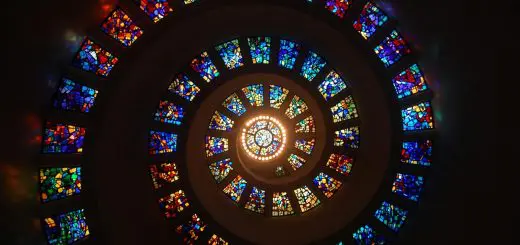What Is the Significance of Sacred Geometry in Spiritual Architecture?

Looking for more amazing products? Check out our online store and explore our collection here! Happy shopping!
Before diving in, please note: This post is for informational purposes only. If you’d like to know more about how we approach topics, feel free to check out our friendly Disclaimer Page.
Hey there, amazing readers! 
We’re committed to delivering quality posts, and your support (even just sticking around despite the ads) means everything to us. So, bear with us, and thanks for helping us keep the good vibes rolling. Now, on to the fun stuff!
TRANSLATE BUTTON AT THE END OF THE ARTICLE
Introduction to Sacred Geometry
Sacred geometry is a fascinating subject that has intrigued architects, artists, and spiritual seekers for centuries.
It is the study of geometric forms and shapes that are believed to hold symbolic and spiritual meanings.
In spiritual architecture, the use of sacred geometry can be seen in the design and construction of temples, churches, mosques, and other sacred spaces.
These structures are not just buildings; they are designed to evoke a sense of awe and reverence in those who enter them.
The intricate patterns and proportions used in these spaces are believed to have a profound impact on the human psyche and spirit.
History of Sacred Geometry
The history of sacred geometry can be traced back to ancient civilizations such as the Egyptians, Greeks, and Mesopotamians.
These cultures used geometric shapes and patterns in their art, architecture, and religious practices.
The golden ratio, also known as the divine proportion, is one of the most famous geometric principles used by these ancient cultures.
It is believed to represent harmony, balance, and beauty, and is found in many of the world’s most famous architectural masterpieces, such as the Parthenon in Greece and the pyramids of Egypt.
Definition and Principles
Sacred geometry is based on the idea that certain geometric shapes and proportions have symbolic and spiritual significance.
These shapes include the circle, square, triangle, and pentagon, among others.
The principles of sacred geometry are rooted in mathematics and are believed to underpin the structure of the universe itself.
By studying these shapes and proportions, spiritual seekers hope to unlock the secrets of creation and understand the interconnectedness of all things.
Influence on Spiritual Architecture
The use of sacred geometry in spiritual architecture is not merely decorative; it is designed to enhance the spiritual experience of those who enter these sacred spaces.
By incorporating geometric patterns and proportions into the design of temples, churches, and mosques, architects seek to create an environment that is conducive to meditation, prayer, and contemplation.
The symmetry and balance of these structures are believed to harmonize the energy of the space and facilitate a deeper connection to the divine.
Symbolism in Sacred Geometry
Each geometric shape used in sacred geometry has its own unique symbolism and meaning.
For example, the circle represents unity and wholeness, while the triangle symbolizes balance and harmony.
The use of these shapes in spiritual architecture is intended to convey these deeper meanings to those who enter these sacred spaces.
By meditating on these shapes and their symbolism, individuals can deepen their understanding of themselves and their place in the universe.
Role in Designing Sacred Spaces
Architects who specialize in designing sacred spaces understand the importance of sacred geometry in creating environments that inspire awe and reverence.
By carefully selecting geometric shapes and proportions that resonate with the spiritual traditions of a particular culture, architects can tailor their designs to enhance the spiritual experience of those who use these spaces.
Whether it is a cathedral, temple, or mosque, the use of sacred geometry is essential in creating a space that is both beautiful and spiritually meaningful.
Connection to Universal Energy
In the realm of sacred geometry, there is a belief that certain shapes and proportions can tap into universal energy fields and channel divine forces into the physical world.
By aligning the design of a sacred space with these universal principles, architects and spiritual seekers hope to create a space that is energetically charged and spiritually potent.
This connection to universal energy is believed to enhance the spiritual experience of those who enter these sacred spaces and facilitate a deeper connection to the divine.
Sacred Geometry in Ancient Civilizations
Ancient civilizations such as the Egyptians, Greeks, and Mayans were masters of sacred geometry.
They used geometric shapes and proportions in their art, architecture, and religious practices to create structures that were not only aesthetically pleasing but also spiritually significant.
The pyramids of Egypt, the Parthenon in Greece, and the temples of the Mayans are just a few examples of how sacred geometry was used to create spaces that were believed to be imbued with divine energy.
Examples of Spiritual Architecture
Some of the most famous examples of spiritual architecture that incorporate sacred geometry include the Chartres Cathedral in France, the Hagia Sophia in Turkey, and the Lotus Temple in India.
Explore the Path to Spirituality and Enlightenment – Start Here.
These structures are renowned for their use of geometric shapes and proportions that are believed to create a harmonious and spiritually uplifting environment.
Visitors to these sacred spaces often report feeling a sense of peace, awe, and transcendence when they enter these architectural masterpieces.
Modern Applications in Design
In modern architecture, the principles of sacred geometry are still being used to create spaces that inspire and uplift the human spirit.
From contemporary churches and meditation centers to yoga studios and retreat centers, architects are incorporating geometric shapes and proportions into their designs to create spaces that are not only visually stunning but also spiritually meaningful.
By drawing on the ancient wisdom of sacred geometry, architects are able to create buildings that resonate with a sense of the divine and help individuals connect to something greater than themselves.
Conclusion: Importance of Sacred Geometry
In conclusion, the significance of sacred geometry in spiritual architecture cannot be overstated.
By incorporating geometric shapes and proportions that have deep symbolic and spiritual meanings, architects are able to create spaces that uplift the human spirit and facilitate a deeper connection to the divine.
Whether it is the use of the golden ratio, the flower of life, or other sacred geometric patterns, these designs have a profound impact on those who enter these sacred spaces.
As we continue to explore the mysteries of the universe and our place within it, the study of sacred geometry will remain a vital tool in creating environments that inspire awe, reverence, and spiritual growth.

The Enlightenment Journey is a remarkable collection of writings authored by a distinguished group of experts in the fields of spirituality, new age, and esoteric knowledge.
This anthology features a diverse assembly of well-experienced authors who bring their profound insights and credible perspectives to the forefront.
Each contributor possesses a wealth of knowledge and wisdom, making them authorities in their respective domains.
Together, they offer readers a transformative journey into the realms of spiritual growth, self-discovery, and esoteric enlightenment.
The Enlightenment Journey is a testament to the collective expertise of these luminaries, providing readers with a rich tapestry of ideas and information to illuminate their spiritual path.
Our Diverse Expertise
While our primary focus is on spirituality and esotericism, we are equally passionate about exploring a wide range of other topics and niches 

To ensure we provide the most accurate and valuable insights, we collaborate with trusted experts in their respective domains 
Our blog originally focused on spirituality and metaphysics, but we’ve since expanded to cover a wide range of niches. Don’t worry—we continue to publish a lot of articles on spirituality! Frequently visit our blog to explore our diverse content and stay tuned for more insightful reads.
Hey there, amazing reader! 
Check out our store here and take a peek at some of our featured products below! Thanks for being awesome!













